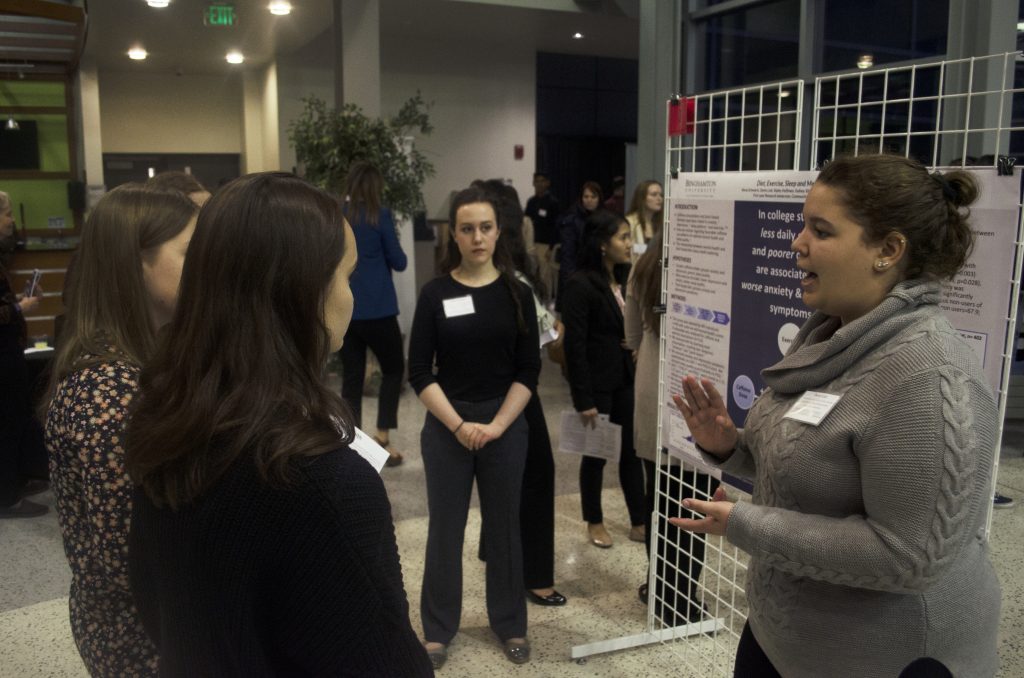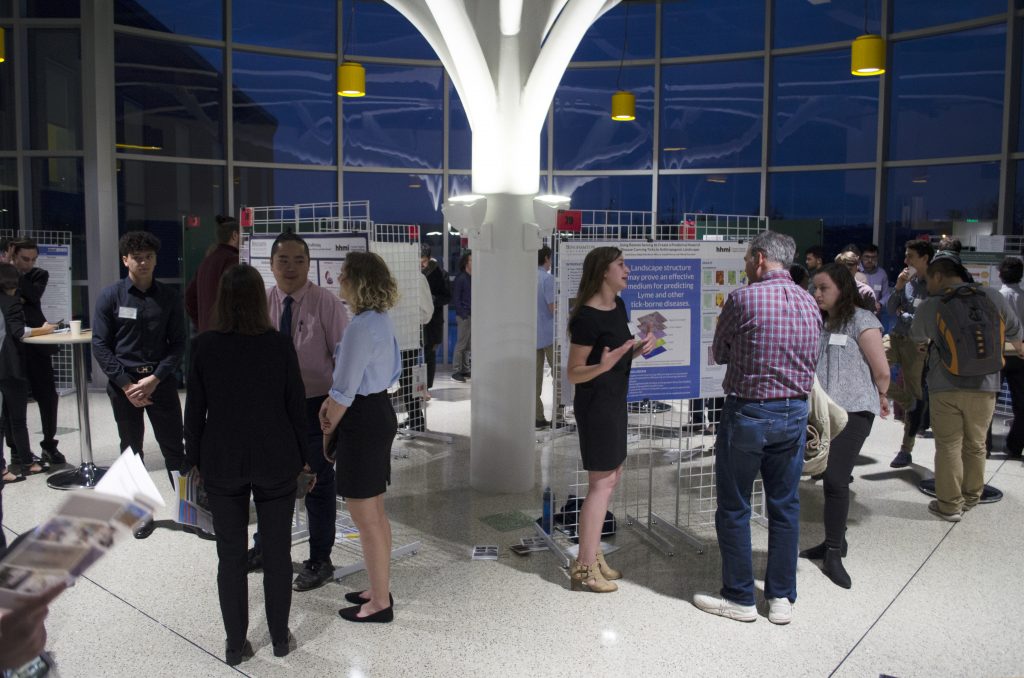
More than 500 Binghamton University students, working on roughly 100 different scientific research projects, participated in the sixth-annual First-Year Research Immersion (FRI) poster session held Thursday afternoon at the Innovative Technologies Complex (ITC).
Megan Fegley, director of FRI, said students participating in the program enroll in a three-semester course sequence that provides freshmen with authentic research experience in selected science, technology, engineering and mathematics (STEM) disciplines.
“The FRI program at [BU] is just one of four programs of its kind in the nation, and the only program of its kind in the northeast which allows students the opportunity to conduct authentic research in their first year of college,” Fegley said.
A total of 101 research project posters lined the halls of the interconnected buildings of the ITC during the two-hour event. The projects stem from 10 distinct research streams, each headed by one or two research educators. Additionally, faculty, graduate and undergraduate student collaborators mentor the FRI students.
Dominic Bossey, a freshman majoring in political science, and Nora Hines, a freshman majoring in environmental studies, are part of a team from the ecological genetics stream, studying the effects of heavy metals on plants grown in the University’s greenhouse.
“We’re looking to see the maternal effects of heavy metals in soil on the plants,” Bossey said.
Lua Lopez Perez, a research assistant professor in the ecological genetics stream of the FRI program, is the lead research educator for Bossey and Hines. Moving forward, Lopez Perez said the thrust of the team’s research is to determine if descendant plants would be better able to tolerate soils with higher levels of heavy metals.
“That is what they are trying to figure out in their study, if, because the parental plants have been growing in a soil with heavy metals, the descendants can better tolerate it,” Lopez Perez said.
Hines said the FRI program had a great influence on her before she even became a BU student.
“I wasn’t sure where I wanted to go to college,” Hines said. “The FRI program is what made me decide to come here.”
Isaac Spiegel, a sophomore majoring in physics, and Gabe Chen, a sophomore majoring in physics, presented their research team’s work investigating the use of drones equipped with magnetometers, sensors capable of accurately detecting unexploded 122mm BM-21 Grad rockets.
Chen said accurate detection using drones equipped with magnetometers can save hundreds of millions of dollars for just one site by preventing needless remediation where none is needed. The project also received attention at another poster presentation this semester.
“There was a Geographic Information Systems (GIS) Day a few weeks ago,” Chen said. “We actually used the same poster, and we won second place overall and first place in the ‘People’s Choice’ category.”
Both Spiegel and Chen said they intend to continue their research on the project next semester through independent studies, along with another team member, Sofia Fasullo, a sophomore double-majoring in geography and mathematics.
Sophie Saremsky, a sophomore double-majoring in computer science and mathematics, Adiel Felsen, a sophomore double-majoring in computer science and mathematics and Richard Quinlivan, a sophomore double-majoring in computer science and mathematics, are part of a team of seven students investigating the use of facial feature recognition capabilities of computer technology to detect early onset fatigue.
“We actually had two parts to our research to determine the symptoms of fatigue,” Felsen said. “We provided three symptoms, which were blinking, eye closure and yawning. We also let the computer learn its own symptoms of fatigue. We would put in frames of the video and the computer would come up with its own features which are totally computer generated. And that was our goal — to combine what we could see with that which may only be obvious with a computer.”
The group’s research is part of the image and acoustic signals analysis research stream. Quinlivan said the results of their research can translate into fewer motor vehicle crashes that result from sleep deprivation behind the wheel of a car.
“Our research can be applied to reduce motor vehicle crashes by creating a system that lets drivers know when they are at a fatigue level that is dangerous to continue driving,” Quinlivan said.
Saremsky said her participation in the program helped her figure out what type of research she wanted to pursue.
“For people in the program, it helps us decide if we are interested in research,” Saremsky said. “I know a lot of people came out saying, ‘I definitely know I don’t want to do research.’ For me, doing this research is what made me feel passion for studying computer science.”



